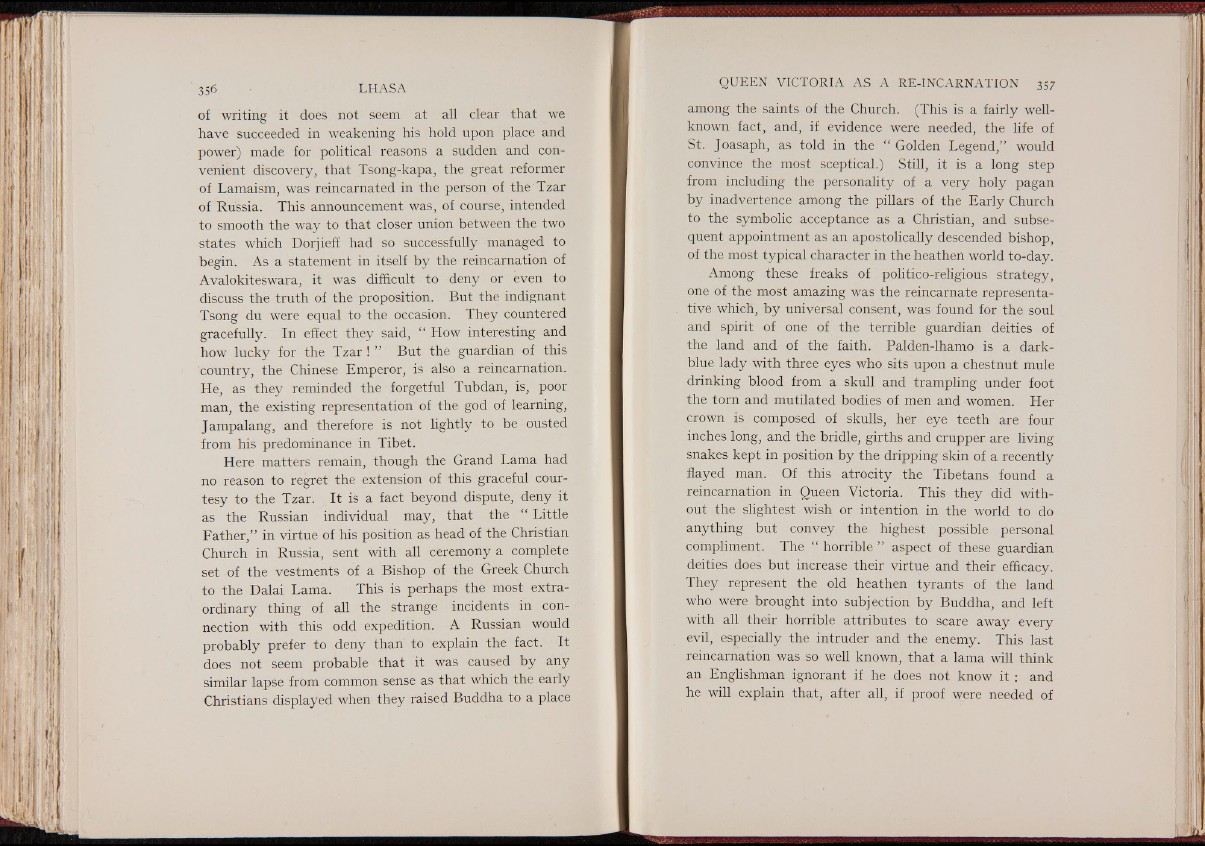
of writing it does not seem at all clear that we
have succeeded in weakening his hold upon place and
power) made for political reasons a sudden and convenient
discovery, that Tsong-kapa, the great reformer
of Lamaism, was reincarnated in the person of the Tzar
of Russia. This announcement was, of course, intended
to smooth the way to that closer union between the two
states which Dorjieff had so successfully managed to
begin. As a statement in itself by the reincarnation of
Avalokiteswara, it was difficult to deny or even to
discuss the truth of the proposition. But the indignant
Tsong du were equal to the occasion. They countered
gracefully. In effect they said, “ How interesting and
how lucky for the Tzar ! ” But the guardian of this
country, the Chinese Emperor, is also a reincarnation.
He, as they reminded the forgetful Tubdan, is, poor
man, the existing representation of the god of learning,
Jampalang, and therefore is not lightly to be ousted
from his predominance in Tibet.
Here matters remain, though the Grand Lama had
no reason to regret the extension of this graceful courtesy
to the Tzar. It is a fact beyond dispute, deny it
as the Russian individual may, that the “ Little
Father,” in virtue of his position as head of the Christian
Church in Russia, sent with all ceremony a complete
set of the vestments of a Bishop of the Greek Church
to the Dalai Lama. This is perhaps the most extraordinary
thing of all the strange incidents in connection
with this odd expedition. A Russian would
probably prefer to deny than to explain the fact. It
does not seem probable that it was caused by any
similar lapse from common sense as that which the early
Christians displayed when they raised Buddha to a place
among the saints of the Church. (This is a fairly well-
known fact, and, if evidence were needed, the life of
St. Joasaph, as told in the “ Golden Legend,” would
convince the most sceptical.) Still, it is a long step
from including the personality of a very holy pagan
by inadvertence among the pillars of the Early Church
to the symbolic acceptance as a Christian, and subsequent
appointment as an apostolically descended bishop,
of the most typical character in the heathen world to-day.
Among these freaks of politico-religious strategy,
one of the most amazing was the reincarnate representative
which, by universal consent, was found for the soul
and spirit of one of the terrible guardian deities of
the land and of the faith. Palden-lhamo is a dark-
blue lady with three eyes who sits upon a chestnut mule
drinking blood from a skull and trampling under foot
the torn and mutilated bodies of men and women. Her
crown is composed of skulls, her eye teeth are four
inches long, and the bridle, girths and crupper are living
snakes kept in position by the dripping skin of a recently
flayed man. Of this atrocity the Tibetans found a
reincarnation in Queen Victoria. This they did without
the slightest wish or intention in the world to do
anything but convey the highest possible personal
compliment. The “ horrible ” aspect of these guardian
deities does but increase their virtue and their efficacy.
They represent the old heathen tyrants of the land
who were brought into subjection by Buddha, and left
with all their horrible attributes to scare away every
evil, especially the intruder and the enemy. This last
reincarnation was so well known, that a lama will think
an Englishman ignorant if he does not know it j and
he will explain that, after all, if proof were needed of